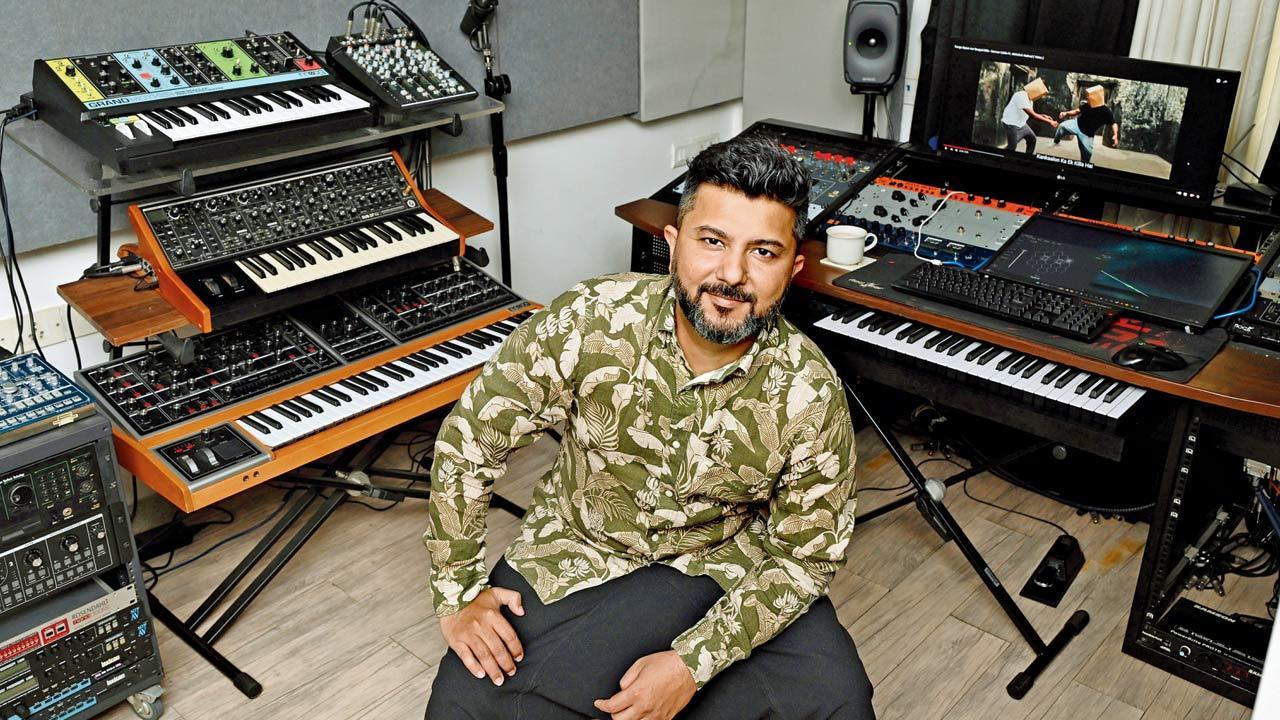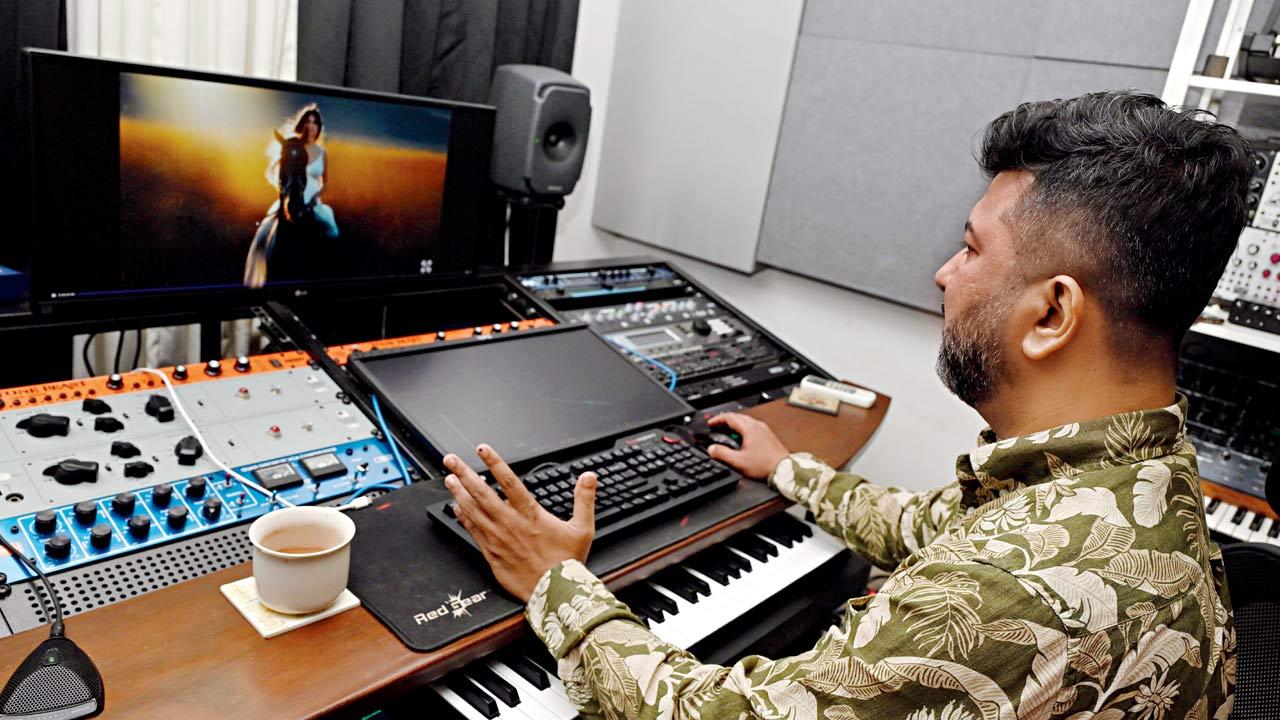Composer Sameer Uddin, who used AI to helm a music video for wife Neha Bhasin, is impressed by its efficiency in styling and creating visual board. But he warns against its limitation in lyric writing

Sameer Uddin. Pics/Satej Shinde
First and foremost, Sameer Uddin is a music composer. But it won’t be wrong to call him a tech geek at heart. The music composer-producer jokes that no matter what he is doing, there is a constant dialogue running in his head about the latest technology available in the market and what to do with it next. Is that how Furqat, Neha Bhasin’s single, happened?
ADVERTISEMENT
Uddin—who recently composed the score for Madgaon Express—turned director for musician-wife Bhasin’s music video. When starting out on the project, it struck him that he could employ AI to create a visual board for the song. “For Furqat, I would have had to hire storyboard artistes and stylists to help me with visualisation of the costumes. Since I didn’t have a lot of experience doing this and had limited resources, I wanted to bring down the error margin as much as possible. So, for costume ideas, I took the help of AI tools like Midjourney and Leonardo. You can train your models into them. So, I trained Neha’s model into the system, and asked it to give some different colour combinations,” he shares. From there was born Bhasin’s look in the video—she sported dramatic white and golden outfits, off-setting the austere background.
 Sameer Uddin designed Neha Bhasin’s costume in the video using AI tools
Sameer Uddin designed Neha Bhasin’s costume in the video using AI tools
Create the vibe
Mention the setting, and Uddin says he sought AI’s assistance to visualise the three-minute video. He inserted pictures taken during recce into the tool. “I would take the recce shots, superimpose Neha’s image and then put it into video text. So, if I have locked a golden costume and this is the backdrop, I first Photoshop them and then I make it into an AI image. You can then ask it to do a movement, or a pan-out to see how it looks.”
Clearly, AI was able to substitute for a few creative jobs like storyboard artistes, stylists, and production designers here. Uddin agrees that it saves cost, but emphasises that the tools aren’t effective on their own yet. “The biggest challenge is that AI doesn’t work for you, at least at this stage. You have to work around it. So, whatever it gives me, I have to make do with it. In contrast, if I’m working with an art director, I can ask him to draw a frame of a woman having a meal at a dining table. In Midjourney, when I put these instructions, it will generate 50 iterations for me, which could be wrong. But with an art director, I can ask for changes. Say, ‘Can you make the frame wider and remove the dining table?’ These tools are not yet effective to serve you on these prompts.”
Imagine it, try it
The musician’s journey with AI began a couple of years ago, when he came across research papers on the technology. Intrigued by it, he began experimenting with it before buying a subscription and making it an active part of his work. “The subscription for Midjourney is $34 dollar monthly. For comparison, even if a good storyboard artiste charges you Rs 5,000 per frame and you have to do 30 to 40 frames for a three-minute video, you can do the math and draw the difference of cost,” breaks down Uddin, who has composed score for several popular Bollywood films, including Kapoor & Sons (2016), Phillauri (2017), and Kaalakaandi (2018).

For him, the joy lies in unlocking new doors of imagination. “You are getting new extensions of tools. For example, if you shot at Sion Fort only to return and realise that you had to take an extra shot, doing it again will cost you lakhs. Instead, I take a 360-degree scan of the place in my camera, put it into Luma [an AI tool] and get a 3D scan of the image.”
Not a wordsmith
Another AI tool that is permanently at Uddin’s disposal is ChatGPT. For his latest single, Ranga siyaar aur bagad billa, the musician used it to write lyrics, apart from composing. “I wanted a [Hindi] word for ‘conformism’. That’s when ChatGPT spat out ‘anumodak’,” he recalls. But he is unimpressed by its efficiency, especially when it comes to poetry. “It’s the lamest tool on the block to generate script and lyrics. I don’t see it matching other tools like image generation or 3D generation, which are getting deeper by the day. Sit on ChatGPT for 20 minutes, you can figure out there is a certain pattern in which it tries poetry. It doesn’t understand vernacular references. Also, it is so heavily morally censored that you cannot expect it to write beyond some floozy poetry. You can’t write a Mirzapur script on ChatGPT because it will say that you can’t use profanity or this is culturally sensitive.”
In the world of sound, Uddin says AI is not of much use yet, but it could make a music composer redundant if it continues to grow. Does the possibility of his own job being threatened not scare him? “We don’t know where this will go. But what we know is that whatever happens in the future, it will be AI plus humans. AI inherently doesn’t need to generate music or images; it’s the human who needs to do that.”
While ascertaining that mid-level or entry-level jobs could suffer due to advancement in AI, the musician is certain human creations will persist. Why? He believes people will always value the human touch that enriches art. “We love human creations. It’s not that directors only like to have great songs from a composer; they also like the process of jamming with them, listening to sounds, and exchanging inputs. Those who value process over fast results will still hire humans,” he smiles.
What is it? To create a music video for singer-wife Neha Bhasin’s single Furqat, Sameer Uddin traded a storyboard artist, stylist and production designer, instead employing AI for the jobs.
How it works? Uddin used Midjourney and Leonardo to generate costume ideas for Bhasin, by training her model into the system. The tools also aided in generating the video as he fed pictures taken during recce into the tool, and superimposed Bhasin’s image to create an AI image.
Who it benefits? It helps independent artistes, who don’t have high budgets for their videos. With the help of the tools, they can skip a few people in the production chain, thus saving costs.
 Subscribe today by clicking the link and stay updated with the latest news!" Click here!
Subscribe today by clicking the link and stay updated with the latest news!" Click here!







